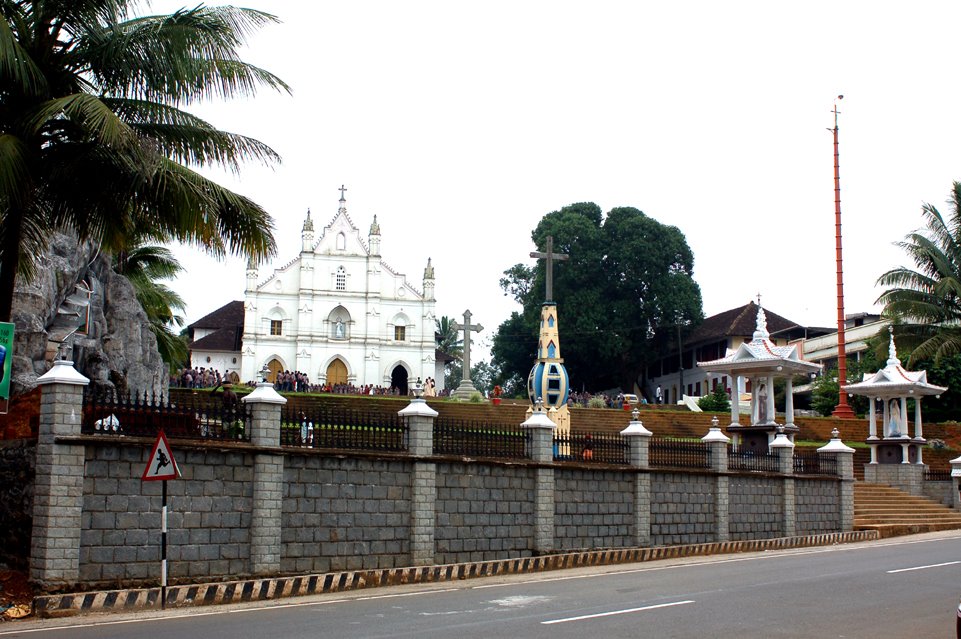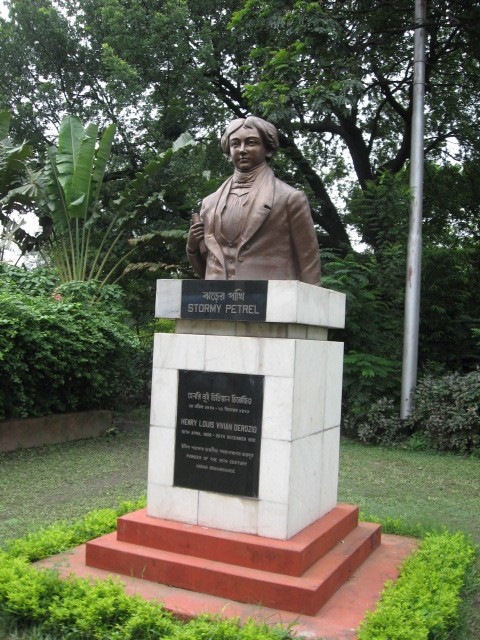|
Bharananganam
Bharananganam, is a Christian pilgrimage centre in South India on the banks of the Meenachil River, away from Pala and from Plassanal, in Kottayam district in the Indian state of Kerala. Agriculture is the main occupation of the people, who cultivate cash crops like rubber. History The place was believed to be an independent territory under Travancore Kingdom immediately governed by vassal Kingdom of Poonjar. It is believed that the place had the Church of Veluthachan who is believed to be a legendary person. The church was later burnt in the 11th century and a new church was built on the opposite bank of the river Meenachil, which lead to the current church also to be named ' Anakallitt palli as an elephant laid its location due to confusion about construction of the church on the north or south bank of river Meenachil. It is also believed to be the birthplace of Kulapurath Bhima a Brahmin born in Kulapurath family of Bharananganam, who is a legendary figure who bui ... [...More Info...] [...Related Items...] OR: [Wikipedia] [Google] [Baidu] |
St Alphonsa
Saint Alphonsa of the Immaculate Conception (19 August 1910 – 28 July 1946), born as Anna Muttathupadathu, was an Indian Catholic nun and educator. She is the first woman of Indian origin to be canonized as a saint by the Catholic Church, and the first canonized saint of the Syro-Malabar Catholic Church. Born in Kudamalur, Kerala, Alphonsa joined the Franciscan Clarist Congregation at a young age. She served as a teacher and faced numerous health challenges throughout her life. Despite her physical sufferings, she was known for her spiritual devotion and cheerful demeanor. Alphonsa's life was marked by simplicity and a deep commitment to her faith. She taught at St. Mary's High School in Bharananganam but her tenure was often interrupted by illness. After her death in 1946, many people began to attribute miracles to her intercession. The process for her canonization began in 1955, and she was beatified by Pope John Paul II in 1986 during his visit to India. In the 1990s, a co ... [...More Info...] [...Related Items...] OR: [Wikipedia] [Google] [Baidu] |
Kottayam District
Kottayam () is one of List of districts of Kerala, 14 districts in the States and union territories of India, Indian state of Kerala. Kottayam district comprises six municipal towns: Kottayam, Changanassery, Pala, Kerala, Pala, Erattupetta, Ettumanoor, and Vaikom. Situated in the south-central part of Kerala, Kottayam shares its borders with Ernakulam, Idukki, Pathanamthitta, and Alappuzha districts. It is the only List of districts in India, district in Kerala that does not border either the Arabian Sea or another Indian state. The district is bordered by hills in the east, and the Vembanad Lake and paddy fields of Kuttanad on the west. The area's geographic features include paddy fields, highlands, and hills. As of the 2011 census, 28.6% of the district's residents live in urban areas, and it reports a 97.2% Literacy in India, literacy rate. In 2008, the district became the first tobacco-free district in India. Kottayam registered the lowest Multidimensional Poverty Index (MPI) ... [...More Info...] [...Related Items...] OR: [Wikipedia] [Google] [Baidu] |
Plassanal
Plassanal is a very small town in Kottayam district, state of Kerala, India. It is 4 km northwest of the town of Erattupetta. Places of interest * Discs and Machines - Sunny's Gramophone Museum and Records Archive: a private museum of gramophone players and a large collection of mainly 78 rpm disc records. Education * St. Antony's Higher Secondary School * Government Lower Primary School * Plassanal Nursery School Hospitals * Holy Family Hospital Religious places * St. Mary's Church * Incholikkavu Temple * Carmelite Convent Accessibility: Nearest cities and towns Nearest Airport - Cochin International Airport Nearest Railway Station- Kottayam railway station Distance to Cochin - 80 km Distance to Kottayam - 37 km Distance to Pala - 9 km Distance to Bharananganam Bharananganam, is a Christian pilgrimage centre in South India on the banks of the Meenachil River, away from Pala and from Plassanal, in Kottayam district in the Indian sta ... [...More Info...] [...Related Items...] OR: [Wikipedia] [Google] [Baidu] |
Pala, Kerala
Pala () is a Municipalities of Kerala, municipality in the Kottayam district of Kerala, India. It is located north of the district headquarters in Kottayam and about north of the state capital Thiruvananthapuram. As per the 2011 Indian census, Pala has a population of 22,056, and a population density of . Pala is situated on the banks of the Meenachil river, Meenachil River and is a major hub of St. Thomas Christian, Syrian Christian culture in Kerala. Etymology Demographics Indian census, Pala had a population of 22,640. Males constitute 49% of the population and females 51%. Pala has an average literacy rate of 98%, higher than the national average of 73%: male literacy is 98.5%, and female literacy is 97.8%, still much higher than the state average. 10% of the population is under 6 years of age. Christians make up 65.09% of the population, Hindus 34.19%, Muslims 0.1%, Jain 0.00%, other religions 0.05% and 0.15% not stated. Cuisine of Pala Appams, kallappams, or vel ... [...More Info...] [...Related Items...] OR: [Wikipedia] [Google] [Baidu] |
Meenachil
Meenachil is the north-eastern region of Kottayam district in Kerala, south India. The name originates from Meenakshi, the Hindu Goddess. Pala is the main city in Meenachil. The arterial river of the district is also named Meenachil. Geography The Meenachil River, also known as Kavanar, Gauna, Valanjar originates at ''vagamon'' in the Western Ghats of Kerala, flows westward through Erattupetta, Palai, Kidangoor, Ettumanoor and Kottayam. Its length is about 87 kilometers. Near Kottayam it splits into a number of distributaries before emptying into the Vembanad Lake. Kumarakom, the bird sanctuary and tourist resort is on one such branch. History The current Meenachil taluk was a principality under the rulers of the royal family often referred to as the '' Meenachil Karthas'' (also known as ''Njavakkat Karthas'') before Marthanda Varma annexed it to Travancore in 1754. The name of the place comes from Goddess Meenakshi, the deity of the ''Karthas''. Veera Kerala Dam ... [...More Info...] [...Related Items...] OR: [Wikipedia] [Google] [Baidu] |
States And Union Territories Of India
India is a federalism, federal union comprising 28 federated state, states and 8 union territory, union territories, for a total of 36 subnational entities. The states and union territories are further subdivided into 800 List of districts in India, districts and smaller administrative divisions of India, administrative divisions by the respective subnational government. The states of India are self-governing administrative divisions, each having a State governments of India, state government. The governing powers of the states are shared between the state government and the Government of India, union government. On the other hand, the union territories are directly governed by the union government. History 1876–1919 The British Raj was a very complex political entity consisting of various imperial divisions and states and territories of varying autonomy. At the time of its establishment in 1876, it was made up of 584 princely state, constituent states and the prov ... [...More Info...] [...Related Items...] OR: [Wikipedia] [Google] [Baidu] |
Portuguese Bombay And Bassein
Portuguese may refer to: * anything of, from, or related to the country and nation of Portugal ** Portuguese cuisine, traditional foods ** Portuguese language, a Romance language *** Portuguese dialects, variants of the Portuguese language ** Portuguese man o' war, a dangerous marine animal ** Portuguese people, an ethnic group See also * * ''Sonnets from the Portuguese'' * "A Portuguesa", the national anthem of Portugal * Lusofonia * Lusitania Lusitania (; ) was an ancient Iberian Roman province encompassing most of modern-day Portugal (south of the Douro River) and a large portion of western Spain (the present Extremadura and Province of Salamanca). Romans named the region after th ... * {{disambiguation Language and nationality disambiguation pages ... [...More Info...] [...Related Items...] OR: [Wikipedia] [Google] [Baidu] |
Luso-Indian
Luso-Indians, or Portuguese-Indians, are people who have mixed Indian and Portuguese ancestry; the term also refers to people of Portuguese descent born or living or originating in former Portuguese Indian colonies, the most important of which were Goa and Damaon of the Konkan region, along the Western coast of the present-day Republic of India. Luso-Indians are one subgroup of Luso-Asians, which includes other Eurasian creole peoples. Their diaspora can be found around the world, particularly in the Anglosphere and the Lusosphere, including constiuents of the former Portuguese East Indies such as Macao. Pockets of Luso-Indians used to live in the parts of India now known as Anjediva, Velha Goa, Damaon, Dio district, St Mary's islands of Mangalore, Bombay (Mumbai), Korlai Fort ( Chaul), Vasai (Bassein), Silvassa, Cape Comorin & Fort Cochin. There are also a number of Koli Christians, Christian Brahmins, Christian Cxatrias & so on with Portuguese surnames but who d ... [...More Info...] [...Related Items...] OR: [Wikipedia] [Google] [Baidu] |
Gonsalo Garcia
Gonsalo Garcia, O.F.M. (; 1556 – 5 February 1597) was a lay brother of the Franciscans from Portuguese Bombay and Bassein in early modern India. He died at the hands of the 16th-century Tokugawa Shogunate of Japan and was canonised along with his companions, the 26 Martyrs of Japan.D'Mello, Ashley, "St Gonsalo Garcia: The 1st Indian saint" ''The Times of India'', 13 October 2008 Historical background Bassein (Vasai) is about 30 miles north of . The Portuguese bega ...[...More Info...] [...Related Items...] OR: [Wikipedia] [Google] [Baidu] |
St Thomas Christians
The Saint Thomas Christians, also called Syrian Christians of India, ''Marthoma Suriyani Nasrani'', ''Malankara Nasrani'', or ''Nasrani Mappila'', are an ethno-religious community of Indian Christians in the state of Kerala ( Malabar region), who, for the most part, employ the Eastern and Western liturgical rites of Syriac Christianity. They trace their origins to the evangelistic activity of Thomas the Apostle in the 1st century. The Saint Thomas Christians had been historically a part of the hierarchy of the Church of the East but are now divided into several different Eastern Catholic, Oriental Orthodox, Protestant, and independent bodies, each with their own liturgies and traditions. They are based in Kerala and they speak Malayalam. ''Nasrani'' or Nazarene is a Syriac term for Christians, who were among the first converts to Christianity in the Near East. Historically, this community was organised as the Province of India of the Church of the East, by Patriarch Timo ... [...More Info...] [...Related Items...] OR: [Wikipedia] [Google] [Baidu] |
Syro-Malabar Catholic Church
The Syro-Malabar Church, also known as the Syro-Malabar Catholic Church, is an Eastern Catholic church based in Kerala, India. It is a '' sui iuris'' (autonomous) particular church in full communion with the Holy See and the worldwide Catholic Church, with self-governance under the ''Code of Canons of the Eastern Churches'' (CCEO). The major archbishop presides over the entire church. The incumbent Major Archbishop is Raphael Thattil, serving since January 2024. It is the largest Syriac Christian church and the largest Eastern Catholic church. ''Syro-Malabar'' is a prefix reflecting the church's use of the East Syriac liturgy and origins in Malabar (modern Kerala and parts of Tamil Nadu). The name has been in usage in official Vatican documents since the nineteenth century. The Syro-Malabar Church is primarily based in India; with five metropolitan archeparchies and ten suffragan eparchies in Kerala, there are 17 eparchies in other parts of India, and four eparchies out ... [...More Info...] [...Related Items...] OR: [Wikipedia] [Google] [Baidu] |






